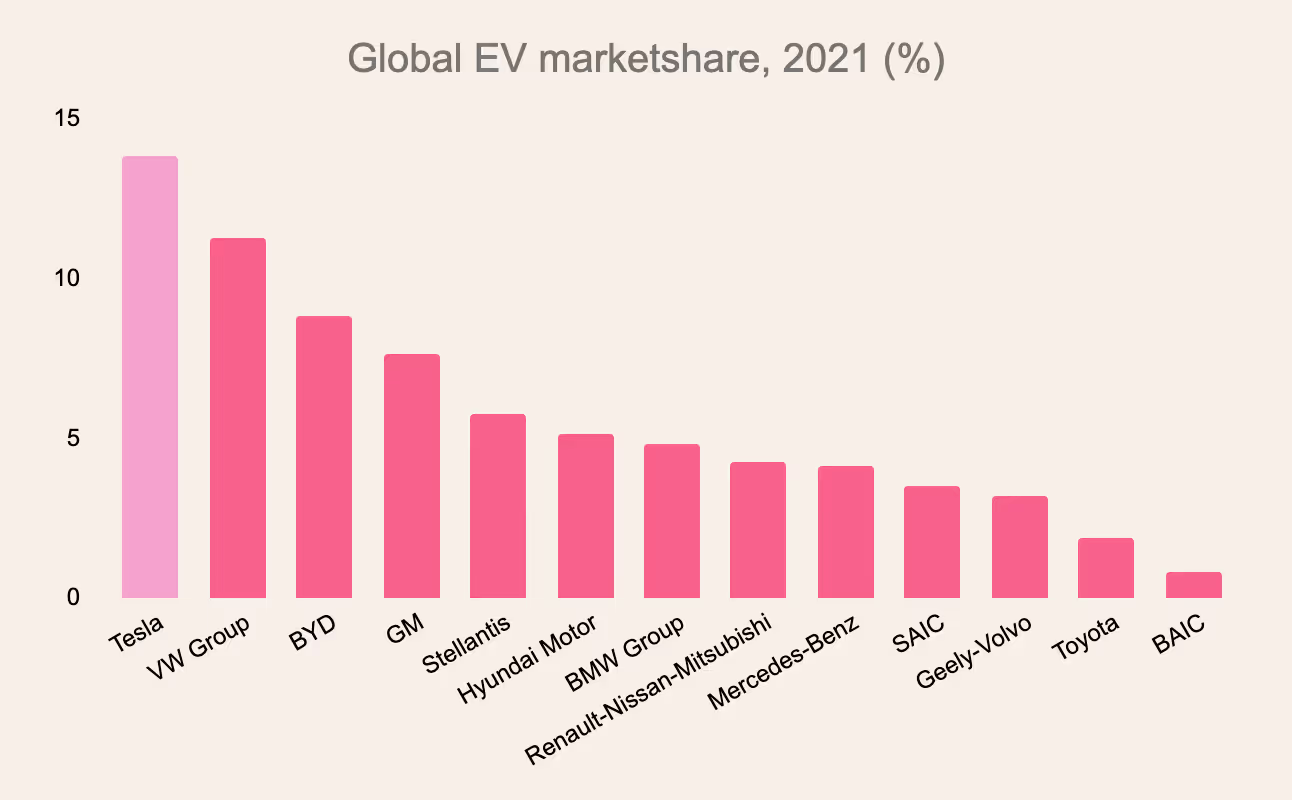Tesla’s first-quarter was a home run. Revenue soared by 81% to $18.8bn and gross profit jumped 147% to $5.5bn compared to last year.
It’s hard to argue that sounds anything but positive and, for a moment, those figures gave investors a little twinkle in their eyes. Tesla’s share price got a slight after-hours boost following yesterday’s earnings release, after a nervy pre-results fall throughout the day.
It’s not the first time that recent news has jolted life into the shares. But after a brief spike last month when the Berlin gigafactory opened its doors Tesla’s share price is already back down. The glitz didn’t last long and there are a few worries this lift won’t either.
So why is it that on many measures, Tesla is smashing it out of the park, yet its share price is hardly reacting?
It’s not that the firm’s huge numbers are falling on deaf ears, it’s just those ears have heard it all before. Enormous as they might be, Tesla’s fans expect big things now. A share price trading on 200x earnings tells us that much.
Expect the (un)expected
Projections and predictions are baked into share prices. That’s the nature of the market. It’s forward-looking, and theoretically, relevant information about a firm’s future should be reflected in what you pay for its stock today.
Of course, this isn’t to say surprises don’t happen and the market isn’t shocked every once in a while. When expectations are at odds with reality, we tend to see more volatility in a share price’s fluctuations.
Even so, we can somewhat predict the unpredictable too. That’s why firms tend to provide ranges when they issue guidance as opposed to a cold hard figure. It’s also why they might issue warnings if they’re worried about some negativity that may come to light in a future earnings release.
For instance, there were grumblings that Tesla wouldn’t meet production targets due to supply chain constraints. Then its Q1 results waltzed in, appeasing those fears and seemingly defying its own manufacturing odds too.
It seems that this expectation was already factored into the price. If Tesla’s share price was any indication, the market saw this coming.
Like what you’re reading? Sign up to Honey by Freetrade for more market news and memes. All the memes.
Reinventing the wheel
Weak share price movements following strong results might be the result of Tesla meeting expectations. Even if these expectations are exceptionally high. It’s as if the market has simply given an approving nod and said ‘carry on’.
And the market’s been nodding for some time now. There’s no question about it, Tesla’s proved stonking share price performance for years.
So how did Tesla get to a stage where soaring revenue growth and record-high profits still don’t do much to move the share price needle?
When Tesla first stepped on the scene in 2003, the vision was simple (though far from easy): make electric cars that are better than diesel or petrol models.
Five years later, Tesla came to market with a car that turned a mission statement into reality.
It doesn’t seem so shocking now, hindsight’s 20-20 after all. But Tesla’s roots help explain why its impressive growth isn’t shocking the market. After all, it was founded with ginormous aspirations and those lofty, world-changing goals are what roped many in from the get-go.

And over the years, Tesla has proven it can do what it set out to do. It’s the EV market leader, and while it has some close competitors, they’re not too hot on its tail yet.
But now it’s looking like an Olympian who just won the gold after weeks of reporters predicting they’d do exactly that. The crowd isn’t as excited as one might have hoped. It kind of feels like the medal was the champion’s to lose. With that box ticked, the next step is maintaining its leadership and exciting the market again.
It might seem trite and superficial, but we saw what happened when Netflix stopped living up to the growth hype.
Tesla has to do something new that the forecasters haven’t accounted for to get the market back up on its toes again.
EVs alone won’t cut it, their success in the industry is already reflected in the share price.
(For a breakdown of what that price is made up of, check out our take on Tesla’s valuation.)
Pedal to the metal
Musk said it himself.
Tesla’s growth driver won’t be its Model 3, it’ll be robots. According to the Technoking, in the coming years they’ll be more important than the firm’s EVs.
If his vision’s to be believed, the Tesla Bot will stand 5ft8in tall, lift 150lb and travel at 5mph. Once they’re built, Musk says they’ll move parts around Tesla’s factories, “or something like that”.
Ok, so maybe the use case isn’t quite set in stone yet. But regardless of what they do, robots are likely the up and coming driver for share price growth.
The firm’s self-driving taxis could lend a helping hand too, though Musk has been clear, his bets are on the bots.
And frankly, for a share price pop, Tesla will have to do something that defies the odds. At its current valuation, there are already massive expectations that the company pulls in consistent, significant EV sales growth as we saw in Q1. But it’s going to take more than the status quo to rationalise the next big jolt.
This is where Tesla can convince investors it’s a life-altering, forward-thinking behemoth that just happens to make cars right now. Sure, volumes will increase and models will develop but as far as investors are concerned, the car proposition’s already in the bag.
Whatever comes next has big shoes to fill. Let’s hope the robots have big feet.

See the most popular investments with a breakdown of the most traded stocks and most popular ETFs on Freetrade. Follow the IPO calendar and keep an eye on exciting new investment opportunities.
This should not be read as personal investment advice and individual investors should make their own decisions or seek independent advice. This article has not been prepared in accordance with legal requirements designed to promote the independence of investment research and is considered a marketing communication.When you invest, your capital is at risk. The value of your portfolio can go down as well as up and you may get back less than you invest. Past performance is not a reliable indicator of future results.Freetrade is a trading name of Freetrade Limited, which is a member firm of the London Stock Exchange and is authorised and regulated by the Financial Conduct Authority. Registered in England and Wales (no. 09797821).
.avif)
.avif)



.avif)
.avif)
.avif)



